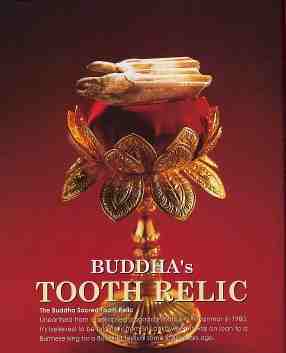
Buddha's Relics

RELICS ENSURED THAT the presence of the Buddha is perpetuated after the passing of the Buddha. They are generally fragments of cremated bones. However, some relics can even appear pearl-like, translucent and multi-coloured.
Relics were always kept in monasteries, where they were enshrined in stupas. For instance, the great stupa at Sanchi, which contains relics of the Buddha, is set in the middle of a large monastic complex. A similar arrangement is found in Sri Lanka, where some of the relics finally came to rest, the most celebrated being the tooth relic at Kandy (see: Buddha's Tooth Relic). It is said that about forty pieces of Buddha tooth relics were distributed to different parts of the world. Myanmar is another country that's popularly known to enshrine Buddha tooth and body relics, alongside with relics of Buddha's disciples.
In China, finger bone of the Buddha was discovered in the 1980s in the forgotten crypt in the Fainen temple (Famensi) in Shaanxi province. Renowned as one of the four places in China with Buddha relics, the Famen temple enjoyed direct imperial patronage, especially in the ninth century.
Before the first century, relics were a key instrument in the spread of Buddhism in helping to establish new centres of religious significance. The practice of venerating relics and images has played a central role even in Buddhist traditions that strongly emphasize that Gautama Buddha was a human being who died and is no longer able to aid his followers. was a human being who died and is no longer able to aid his followers.
Buddha's Seven Coloured Relics
These pearls-like translucent multi-coloured relics are the corporeal remains of Buddha after his cremation. Each colour represents different parts of his body
Early accounts of the Buddha's death include the story of how his cremated remains were divided into portions and distributed among local rulers who enshrined them throughout northern India. What is more telling, however, is the description of how the Mallas, in whose territory the Buddha died, initially sought to keep all the relics for themselves.
When a terrible war was about to ensue, a Brahman or priest named Drona intervened, saying: "Our Buddha was a teacher of forbearance. Unfitting indeed is this clash of arms over the division of the (Buddha's) remains. May you all be united, sirs, reconciled; rejoicing together we shall make eight portions; relic monuments will be widespread in all directions."
This story provides a dramatic object lesson in both the great value accorded to the Buddha's remains and in dangers of selfish attachment. The resolution of the story suggests that the Buddha's relics are so precious that they should be widely distributed and thus made accessible to as many people as possible.
Whatever the historical legitimacy of any particular relic, the practice of relic veneration has been critical to the spread and maintenance of Buddhist tradition for more than two and the half millennia.
**************** Note:
According to Buddhist scriptures, the Buddha left 40 tooth relics to future generations to be worshipped. Among them, four tooth relics were conveyed to the Dragon King, the lord of the Nat Devas (Dhajia Min), Kandra (now Sri Lanka) and Kalika (now China). The rest of the 36 tooth relics were scattered to the present human world.During the distribution of Buddha's relics, two monks, Gawunpadi and Kuthlayone delivered a few tooth relics to several other monks. One of the tooth relics, from the lower left side of Buddha's jaw, was received by the monk named Buhala and conveyed to the Rakhine State (Arakan) in what is known as Myanmar today.
At that time King Mahasandra (Weidali Dynasty) built a pagoda situated on the mountain called Bagan and that particular Buddha's tooth relic was enshrined in it. The pagoda was subsequently named Bagan Pagoda and was estimated to have been built some 2,300 years ago near Mrauk-U.
When the pagoda collapsed in 1980 due to natural wear and tear from the elements, an abbot of Mrauk-U discovered the Buddha tooth relic together with a 9-feet Buddha Image and other Buddha images made by lead mixed with earth and soil.
When the abbot compared it with a100-year old tooth relic that already existed in his monastery, to his surprise, he discovered that it was similar to the famous tooth relic from Sri Lanka. He immediately realized the significance of the new find.
Today, Golden Pagoda Buddhist Temple (GPBT) is fortunate to be a custodian of this particular tooth relic as a gift from the abbot who discovered it in Myanmar. The abbot of GPBT, Venerable Shi Fazhao, attributes this rare chance to merits that GPBT gained in the process of rebuilding temples in Bagan, Myanmar
Date: 5th July 2002
Return to Singapore DharmaNet


